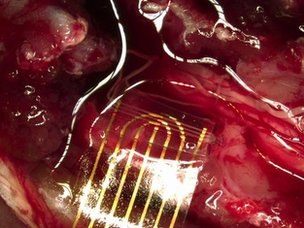New generation bionics — wireless and touch-sensitive
March 14, 2012 | Source: BBC News

Neural interfaces would be embedded in nerve trunks to read and transmit signals (credit: Centre for Brain Repair, Cambridge University)
A new generation of bionics that can connect wirelessly with the nervous system are under development.
Animal tests have already been conducted in which devices are implanted directly into the nerve to process and transmit signals wirelessly to an external device.
Other researchers are developing prosthetic skin that might wrap around a bionic limb and feed back sensory information to the nervous system, in theory enabling users to detect and feel objects.
The current generation of bionic hands can pinch or grasp using two or more electrodes fitted inside the portion of the prosthetic which fits over the stump.
These electrodes are positioned to pick up signals from the user’s peripheral nerve system that are naturally amplified by muscles in the stump.
German company Otto Bock has developed a hand incorporating multiple electrodes that can drive wrist flexing and rotation. Scottish company Touch Bionics builds hands that use software to control individual finger movement, so that the hand can clasp around objects.
The surgical rewiring of nerves in an amputee can also offer a great deal, enabling those with no arm at all, for example, to drive bionic arms with elbow and hand movement.
Wireless bionics
Scientists such as Prof James Fawcett, of the Centre for Brain Repair at Cambridge University, are meanwhile developing neural interfaces whereby prosthetics will communicate wirelessly with implants fitted directly into the nerve fibers in a stump.
Once the device is inserted into the nerve, nerve fibres grow through it. Nerve signals associated with particular movements are then selected, and these signals transmitted wirelessly to a receiver in the prosthetic.
Researchers in Italy are also working on wiring bionics to the peripheral nerve system, and have already conducted trials in which electrodes temporarily connected to the nerves were used to drive an unattached prosthetic hand.
Prosthetic skin
Elsewhere, researchers are looking to make more responsive prosthetics with many looking to flexible electronics or “prosthetic skin” to do the job.
Eventually, such sensors might feed information back to the brain via neural interface devices.
In Switzerland, researchers are testing a thought-controlled wheelchair that uses electrodes placed on the skin in a skullcap to drive the chair.